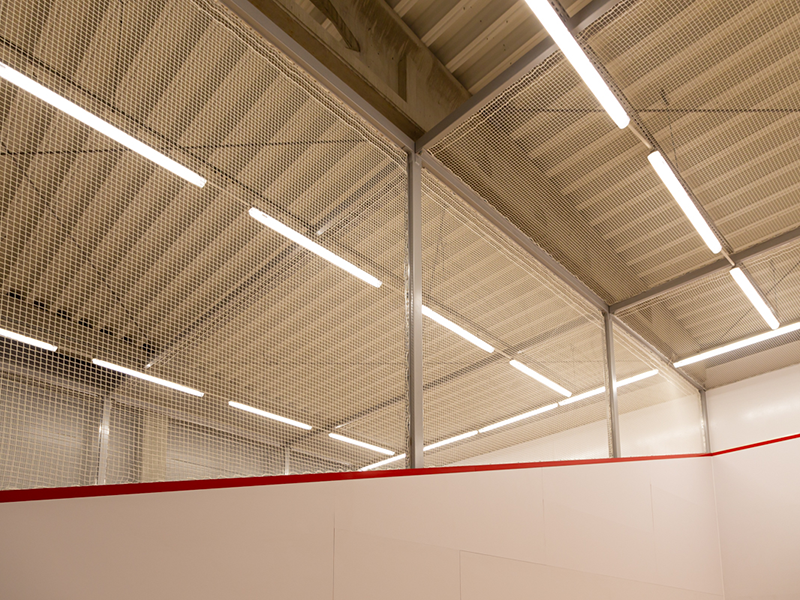SQUASH - RULES, PREPARATION OF THE COURT AND PLAYING EQUIPMENT
2024-09-27

Squash is a dynamic and physically demanding sport. You don't need much to practise it - in terms of both equipment and space. Find out how to play squash, the rules of this fast and addictive sport and how to prepare the court for the game.
SQUASH - THE RULES OF THE GAME ORIGINATING IN THE BRITISH ISLES
In simple terms, squash involves two players bouncing a ball against a field drawn on a wall in such a way that the opponent is unable to strike it. However, this game has its own detailed and elaborate rules. It also has a standardised scoring method - the PARS system. How does a squash game work?
The match starts with a service. Which player performs it is decided by a draw of lots. The opponent must strike the served ball when it bounces off the front wall of the court and bounces once off the floor. Then the rules change. After a successful service and after the ball struck by the opponent, it is also struck if it hits the side wall beforehand. A player wins the exchange and scores a point if his or her opponent:
• incorrectly serves the ball - when it hits a spot on the wall outside the designated area;
• does not pick up the ball he or she has struck against the wall.
What is STORK and LET in squash?
During official squash games, the referee may order a LET - in a situation where it is uncertain who scored a point. The current ball exchange is then cancelled and renewed. This situation occurs, for example, if the referee concludes that:
• a player has obstructed his or her opponent in such a way as to make it impossible for him to strike the ball;
• a player refrained from striking the ball as this could cause injury to his or her opponent.
The referee signals the LET by forming the letter ‘L’ with his index finger and thumb. STORK, on the other hand, indicates a point awarded to the player asking for a LET. The judge signals the award of a point by raising a clenched fist.
Scoring in squash
A squash match consists of three sets. They used to be played until the first player scored 9 or 15 points. PARS - point-a-rally scoring - is now in effect. According to its rules, all ball exchanges must end in winning points. A player must have 11 points and a 2 points more than his or her opponent to win a set.
You may be interested in: Tennis - learn about the rules of the game and scoring.
WHAT DO YOU NEED TO PLAY SQUASH?
To play squash, you need the right court, racquets and... great fitness! The ball exchanges between THE players are very fast, especially for advanced players, so they are always working out a good sweat in the court.
A squash court - how do you prepare it?
According to the rules established by the International Squash Federation, the playing court should have the following dimensions:
• length: 9,750 mm;
• width: 6,400 mm.
The court must be in a room enclosed on four sides. Its floor can be covered with parquet. Professional squash rooms have a glass back wall.
A court for recreational games can also be arranged in a smaller room or in a larger hall divided into separate court areas. A robust polypropylene net will then come in handy.
POLYPROPYLENE NETTING. 2.3 mm STRAND, 2 x 2 cm MESH for separating a squash court.
This squash net has a strong strand and is made from durable polypropylene, so it can stop fast moving balls. Its installation will help you arrange a comfortable and safe place to play.
What does a squash racquet look like?
A squash racket resembles a tennis racquet only at first glance. They differ from one another:
• weight - a tennis racquet frame weighs no more than 330 g, while a squash racquet can weigh up to 400 g;
• the shape of the head - a tennis racquet is oval, whereas a squash racquet can also have a teardrop shape (although this is not the rule);
• string tension - in the case of tennis racquets, this ranges from 20 to 30 kilograms as standard; in squash racquets, the string tension is lower, ranging from 14 to 18 kilograms.
The head area of a squash racket is 450-550 cm². The bigger it is, the easier it is to hit the ball.
A squash racquet can be made of aluminium, composite or graphite. Aluminium models are the heaviest, but also the cheapest, which is why they are often chosen by beginner players. On the other hand, if you want to buy a racquet made of graphite, you have to “reach deeper into your wallet” - but this is the equipment used by professionals.
Squash ball - types
There are four types of squash balls. They are marked with coloured dots. Balls with:
• a blue dot (or without dots) are fast and bounce high; they are used by beginner amateur squash players;
• a red dot also bounce high, but are medium-fast; they are used in training and for recreational play;
• a yellow dot bounce slowly and low, which is why they are mostly used by experienced players;
• two yellow dots are the slowest and bounce the lowest; they are used during tournaments.
Squash balls are warmed up to 45 °C before playing. Only then do they gain their properties and can bounce off walls and the ground.
Playing squash is a great idea for active leisure and this discipline is becoming increasingly popular among Poles. This is why it is worth investing in courts where amateurs can play exciting matches.





